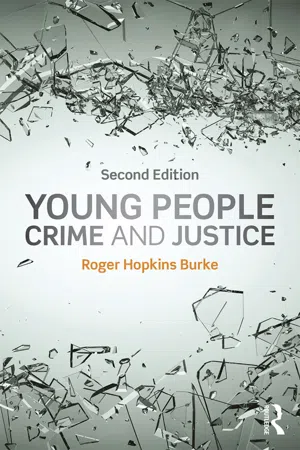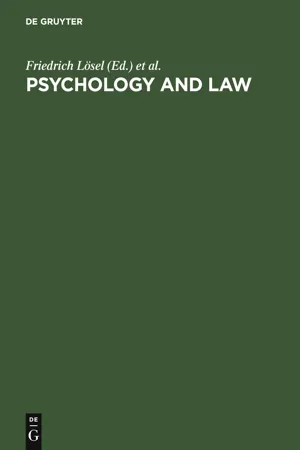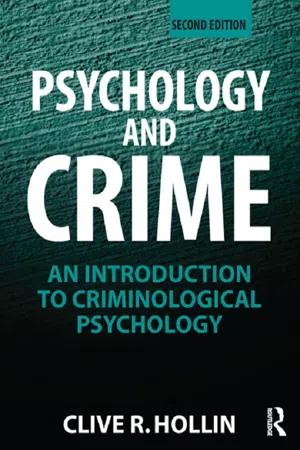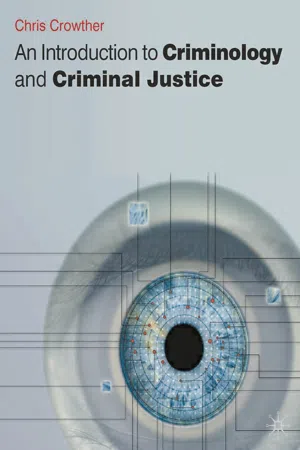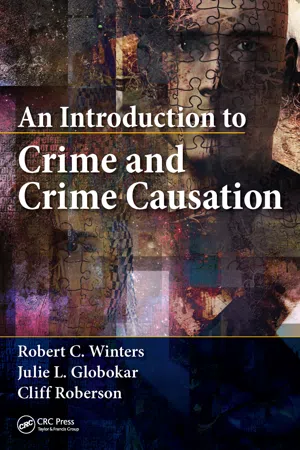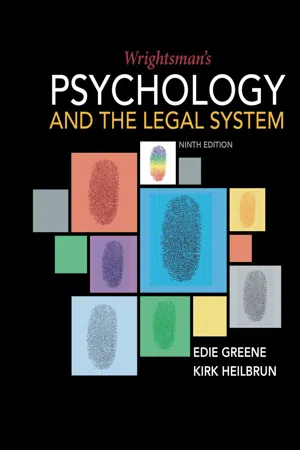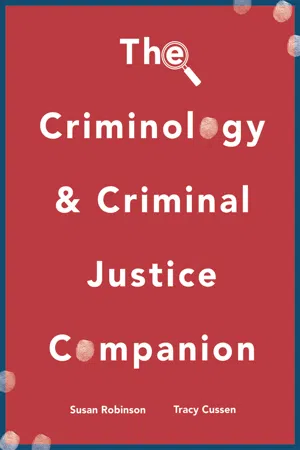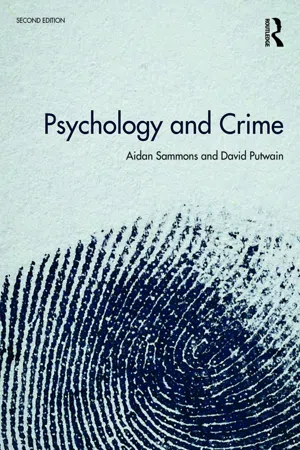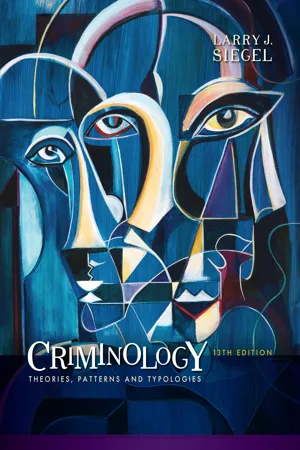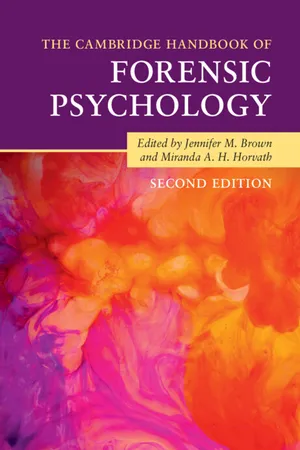Psychology
Psychological Theories of Crime
Psychological theories of crime seek to understand the underlying psychological factors that contribute to criminal behavior. These theories explore how individual differences in personality, cognition, and emotions may influence criminal tendencies. They also examine the impact of environmental and social factors on the development of criminal behavior, aiming to provide insights into the prevention and treatment of criminal conduct.
Written by Perlego with AI-assistance
Related key terms
1 of 5
12 Key excerpts on "Psychological Theories of Crime"
- eBook - ePub
- Roger Hopkins Burke(Author)
- 2016(Publication Date)
- Taylor & Francis(Publisher)
9 Psychological explanations of youth crime
DOI: 10.4324/9781315773100-9Key issues- Psychodynamic theories
- Behavioural learning theories
- Cognitive learning theories
- Conclusions
Psychological explanations of offending behaviour direct our attention to the mind of the individual and it is here that we encounter notions of the ‘criminal mind’ or ‘personality’. For purist advocates of the psychological variant of the predestined actor model – or psychological positivists – there are patterns of reasoning and behaviour that are specific to offenders and these remain constant regardless of their different social experiences. There are three broad categories of Psychological Theories of Crimes and while the first two groupings, psychodynamic and behavioural learning theories, have firm roots in the predestined actor tradition, the third group, cognitive learning theories, reject much of the positivist tradition and, in their incorporation of notions of creative thinking and, thus, choice are, in many ways, more akin to the rational actor model of criminal behaviour. Each tradition, nevertheless, proposes that the personality is developed during the early formative childhood years of the individual through a process of learning, much of which is subconscious.Psychodynamic theories
Psychodynamic explanations of criminal behaviour have their origins in the extremely influential work of Sigmund Freud (1856–1939) and his theories about how our personalities develop as an outcome of our intimate relationships – or lack of these – with our parents and, in particular, our mother. His assertion that sexuality is present from birth and has a subsequent course of development is the fundamental basis of psychoanalysis and it is one that has aroused a great deal of controversy. Freud had originally proposed that it was the experience of sexual abuse in childhood that is the basis of all neurosis, but he subsequently changed his mind: the abuse had not actually taken place but was merely fantasy. It is this notion of the repressed fantasy that is the core tenet of the psychoanalytic tradition. - eBook - PDF
Psychology and Law
International Perspectives
- Friedrich Lösel, Doris Bender, Thomas Bliesener, Friedrich Lösel, Doris Bender, Thomas Bliesener(Authors)
- 2011(Publication Date)
- De Gruyter(Publisher)
The basically neglected explanation of delinquent behavior is an urgent issue, especially in view of treatment and prevention concepts (Lösel, 1983). But in terms of both a relationship between the various areas of research and in generating theories, psychology has occasionally tended to maintain a piecemeal-isolationist stance. There is little or no attempt to draw together the various aspects of psychological inquiry, such as say on the police, the courts, and the offender, in a unified way so as to make sense of the overall picture. Psychological theories of criminal behavior can therefore be criticized for concentrating too much on the individual offender to the neglect of the context of the crime. In short, psychology has in the main been about crime; what is lacking is a psychology of and for crime (Hollin, 1989). In criminology there exists a striking multitude of theories and speculative hypotheses, and, on the other hand, a multitude of results on single variables. Even if given explanations compete with each other only partially, the question of assessment criteria and comparison of theories arises, especially in view of the fact that comparatively rigid hypothesis tests For a detailed discussion of this topic see Montada (1990). 28 Günther Kaiser are rare and yield partly unsatisfactory results (Lösel, 1983). Furthermore, common approaches such as learning theory turn out to be irrelevant in practical applications (Keupp et al., 1989; Kornadt, 1988; Lösel et al., 1990), so that the partly contradictory implications of different scientific theories have to be adapted to the practical issue at hand. Current concepts such as that of life-style remain more or less descriptive and limited in their significance (Kaiser, 1990b). In comparison to crime-sociological approaches, crime-psychological explanations are derived to a somewhat greater extent from general behavior theories. - eBook - ePub
Psychology and Crime
An Introduction to Criminological Psychology
- Clive R. Hollin(Author)
- 2013(Publication Date)
- Routledge(Publisher)
3 Psychological theories applied to crime
In this chapter, the focus is on the way in which psychological theories have been applied to formulate an understanding of criminal behaviour. In order to help appreciate the way in psychological theories have unfolded over time, the various theories are shown in chronological order in Box 3.1 . It should be said that this way of presenting the flow of theory gives a rather neat appearance to what is, in truth, a far from precise process. Theories do not start and stop at exact dates and their development may be traced to an interaction between historical period and the personal characteristics of the theoretician (Simonton, 2002). There is often a period of time, during which the empirical evidence accumulates and the associated academic debate take place, before the full exposition of a given theory. Further, there is not an exact point at which a favoured theory is universally abandoned for another theory. Indeed, most of the theories discussed below, from the earliest to the most recent, are still alive and well, although sometimes in a different form to which they first appeared.It is also the case, within and across disciplines, that not every researcher and practitioner holds the same theoretical views. In different disciplines there may be diverse means by which a theory changes and develops. Thus, contemporary psychology relies heavily on scientific method and empirical evidence as the means by which to advance theory. In philosophy, on the other hand, the picture is different, as described by Russell:Philosophy, as I shall try to understand the word, is something intermediate between theology and science. Like theology it consists of speculations on matters as to which definite knowledge has, so far, been unascertainable; but like science, it appeals to human reason rather than authority … between theology and science there is a No Man’s Land, exposed to attack from both sides; this No Man’s Land is philosophy. - Chris Crowther-Dowey(Author)
- 2017(Publication Date)
- Red Globe Press(Publisher)
The aim here is to simply provide some flavour of a small selec-tion of psychological approaches, in particular psychodynamic theory, cognitive development theory, several variants of social learning theory, and Eysenck’s trait theory of personality. Psychodynamic theories Psychological Theories of Crime begin with the view that individual differences may make some people more predisposed than others to commit criminal acts. The relevant differences may be personality characteristics or biological factors, or may be related to social interaction. Psychoanalytical theory, as developed by Sigmund Freud (1961), concentrates on the personality structure and its influence on human behaviour. Psychoanalysis is based on the assumption that all human beings have natural urges and drives, some of which are buried in the subconscious and unconscious. All humans have criminal tendencies built into their unconscious. For example, there are drives making people aggressive and jeal-ous, and these urges may become manifest in the form of violent and/or property offences. Human beings are not left to their own devices, though: they are exposed to socialization . This occurs during childhood, when most children learn to control their inner drives. However, those people who become criminals experience difficulties during their childhood and are not socialized effectively. Freud (1961) suggested that a common factor accounting for criminal behaviour is a child who fails to identify with his or her parents. Because the child is not properly socialized, a possible consequence is a personality disturbance resulting in antisocial behaviour. These impulses may be directed inwardly or outwardly, depending on the nature of the disturbance the person experiences. The person who displays this distur-bance outwardly becomes a criminal, whereas if it is channelled inwards the behavioural response is neurotic .- eBook - PDF
- Robert C. Winters, Julie L. Globokar, Cliff Roberson(Authors)
- 2014(Publication Date)
- Routledge(Publisher)
79 Chapter four: Biological and psychological approaches to crime causation Summary • Trait theories explore the influence of biology and psychology on criminal behavior. • Unlike early trait theorists, modern trait theorists acknowledge that the effects of biology and psychology are mediated by environmental factors. • Modern trait theorists benefit from tools such as genetic testing and brain imaging to gather data. • Contemporary criminologists have been slow to embrace the trait perspective, tend-ing to favor sociological explanations of crime. • Because of the dearth of fully developed biological and Psychological Theories of Crime, modern trait theorists draw heavily on other fields such as psychology and behavior genetics. • Biological theories of crime can be broken down into four categories: genetic, neuro-physiological, biochemical, and evolutionary. • There is some evidence of a genetic basis for criminal behavior, although the effects are heavily mediated by the environment. • Crime can best be understood as a polygenic trait—no single gene can explain crimi-nal behavior. • There are three types of genes–environment correlations: passive, reactive, and evocative. • Changes in brain structure and functioning can affect behavior. • There is evidence that androgens, or male hormones, are linked to aggressiveness, competitive behavior, and violence. • The neurotoxicity hypothesis holds that exposure to environmental toxins can increase the risk of criminal behavior. • Alcohol consumption is strongly correlated to crime. • Alcohol can affect crime through several mechanisms: It reduces impulse control, sensitivity to pain, and perceptions of risk, and impairs cognition. • Drugs are linked to crime through several mechanisms: The effects of some drugs are conducive to violent crime, addiction can foster economic compulsive crimes, and the illegal drug trade is characterized by systemic violence. - eBook - PDF
- Edith Greene, Kirk Heilbrun(Authors)
- 2018(Publication Date)
- Cengage Learning EMEA(Publisher)
Social–Psychological Theories of Crime Social–psychological explanations view crime as being learned through social interaction. Sometimes called social-process theories in order to draw attention to the processes by which an individual becomes a crim-inal, social–psychological theories fall into two subcat-egories: control theories and direct learning theories. Control theory assumes that people will behave anti-socially unless they learn, through a combination of inner controls and external constraints on behavior, not to offend. Learning theory stresses how individuals directly acquire specific criminal behaviors through dif-ferent forms of learning. Control Theories. Control theories assume that peo-ple will behave antisocially unless they are trained not to by others (Conger, 1980). Young people are bonded to society at several levels. They differ in (1) the degree to which they are affected by the opinions and expec-tations of others, (2) the payoffs they receive for con-ventional behavior, and (3) the extent to which they subscribe to the prevailing norms. Some people never form emotional bonds with significant others, so they never internalize necessary controls over antisocial behavior. Reckless’s (1967) containment theory is an example of a control theory. Reckless proposed that it is largely external containment (i.e., social pressure and institu-tionalized rules) that controls crime. If a society is well integrated, has well-defined limits on behavior, encour-ages family discipline and supervision, and provides reinforcers for positive accomplishments, crime will be contained. But if these external controls weaken, con-trol of crime must depend on internal restraints, mainly an individual’s conscience. Thus, a positive self-concept becomes a protective factor against delinquency. - eBook - ePub
- Elaine Cassel, Douglas A. Bernstein(Authors)
- 2007(Publication Date)
- Psychology Press(Publisher)
5 Psychological Roots of CrimePersonality and Crime Learning and Crime Traits and Crime Cognition and Crime Psychodynamics and Crime Personality Disorders and Crime I n chapter 4 , we considered biological roots of crime, including the influence of genetic inheritance, the brain and central nervous system, and hormonal and other physiological mechanisms that influence aggression and violence. In this chapter, we introduce the psychological theories that attribute the roots of crime to mental processes that develop as people interact with their families and others. We focus on the major psychological theories of personality and personality development as well as on theories about how people process information, think, learn, and interact with others. We then apply these concepts as we trace the development of crime and mental disorders in chapters 7 , 8 , and 9 .Personality and Crime
We begin by looking at psychologists’ efforts to develop theories about what personality is, how it can best be measured, how it develops, and how it might be changed.In describing someone’s personality, people usually employ adjectives such as “friendly,” “kind,” “warm,” or perhaps “difficult,” “hostile” or “insecure.” In doing so, one is trying to summarize the essence of that person’s behavior and attitudes, the characteristics that describe a particular individual. Most psychologists agree that personality consists of the unique patterns of thinking, feeling, and behaving that are relatively constant throughout one’s life and through which one can be compared and contrasted with other people.Where does personality come from? It begins with the biological predisposition to act and respond to the world in particular ways, which psychologists call temperament - Susan Robinson, Tracy Cussen(Authors)
- 2017(Publication Date)
- Bloomsbury Academic(Publisher)
Criminological Theory in Context The word ‘theory’ originates from the Greek word thorós which means ‘spectator’. A theory is a system of ideas, assumptions or propositions that attempt to explain observed phenomena that in some cases may be abstract in nature. It is a rational way of thinking about a topic so as to link cause and effect and is arguably an attempt to make the intangible tangible. Some definitions of theory, usually scientific, define a theory as being a hypothesis that is backed up by evidence. Theories are mental maps or conceptualisations to explain perceived reality. In criminology, theories seek to explain the occurrence and prevention of crime, why some people commit crime, why some people fall victim to crime and how criminals and victims are processed by the criminal justice system. It is worthwhile to briefly expand on the role of theory in a criminological context and why theories are important in criminological study. Why Is Criminological Theory Important? Criminological theories can guide the student’s search to understand why people do or do not commit crime; help identify what information is needed to design an effective intervention strategy to apprehend offenders; and provide insight into how to design a programme so it is successful in reducing offending. Theories and models help to explain behaviour as well as suggesting how to develop more effective ways to influence and change it. There are two broad types of theory – explanatory theory and change theory – which may have different emphases but are complementary to each other. For example, understanding why a person steals is one step towards preventing Key Theories and Theorists 3 > Why is theory important to criminology? offending, but even the best explanations won’t be enough by themselves. Some type of change model will also be needed to complement the theoretical explanation of causation.- eBook - PDF
Psychology and Crime
2nd edition
- Aidan Sammons, David Putwain(Authors)
- 2018(Publication Date)
- Routledge(Publisher)
37 The previous chapter examined criminality from a biological perspective. This chapter presents a number of individual psychological perspectives on offending including unconscious motivations, personality and cognitive processes. The range discussed here is by no means exhaustive but gives some indication of the diversity of psychological views on criminal behaviour. The distinction between ‘biological’ and ‘psychological’ perspectives is somewhat arbitrary and, in the case of person-ality theory and psychopathy, there is inevitably a crossover. This to be expected since a long-term tendency within psychology as a field is to integrate biological, psychological and social perspectives. C H A P T E R 4 Psychologically oriented explanations of offending Apply your learning Alan, a reformed offender, describes how he ended up in prison: I grew up in the recession of the 1970s. Jobs were scarce. My teachers didn’t expect much of me and saw me as a troublemaker. My father was violent towards my mother. I loved my mum and I hated the way he treated her but I came to see that the world was full of victims and perpetrators and I didn’t want to be a victim. In my teens I started hanging around with a gang, nothing that serious. We’d go out drinking and there were rivalries with other gangs. One night we were in a bar and this lad knocked my drink over. Next thing I knew we were all over him, kicking and punching him. I stabbed him. I was revolted but at the same time I needed to show everyone that I was a hard man. How could the psychological theories discussed in this chapter explain Alan’s offending? Which do you believe provides the most plausible explanation and why? Psychodynamic theories Starting with Sigmund Freud, a number of psychoanalytical thinkers have turned their attention to crime as one possible manifestation of irrational, unconscious, chapter 4 Psychologically oriented explanations of offending 38 pathological processes. - eBook - PDF
Criminology
Theories, Patterns and Typologies
- Larry Siegel(Author)
- 2017(Publication Date)
- Cengage Learning EMEA(Publisher)
uni25A0 The strengths of the theory are that it shows why criminal behavior patterns change over time as people mature and develop their reasoning powers. It may explain the aging-out process. uni25A0 The research focuses of the theory are perception and cognition. Copyright 2018 Cengage Learning. All Rights Reserved. May not be copied, scanned, or duplicated, in whole or in part. WCN 02-300 CHAPTER 5 TRAIT THEORIES 169 Personality and Crime Identify the elements of personality related to crime Personality can be defined as the reasonably stable patterns of behavior, including thoughts and emotions, that distin- guish one person from another. 257 One’s personality reflects a characteristic way of adapting to life’s demands and prob- lems. The way we behave is a function of how our personal- ity enables us to interpret life events and make appropriate behavioral choices. Can the cause of crime be linked to personality? The association between personality traits and crime has a long history. Sheldon Glueck and Eleanor Glueck identi- fied a number of personality traits that they believe charac- terize antisocial youth: 258 self-assertiveness lack of concern for others defiance extroversion feeling unappreciated ambivalence distrust of authority impulsiveness poor personal skills narcissism mental instability suspicion hostility destructiveness resentment sadism Psychologist Hans Eysenck linked personality to crime when he identified two traits that he associated with antiso- cial behavior: extroversion-introversion and stability-instability. Extreme introverts are overaroused and avoid sources of stimulation; in contrast, extreme extroverts are unaroused and seek sensation. Introverts are slow to learn and be con- ditioned; extroverts are impulsive individuals who lack the ability to examine their own motives and behaviors. Those who are unstable, a condition Eysenck calls “neuroticism,” are anxious, tense, and emotionally unstable. - Jennifer M. Brown, Miranda A. H. Horvath(Authors)
- 2021(Publication Date)
- Cambridge University Press(Publisher)
Explanatory theories are of particular value when it comes to developing intervention plans for individuals with psychological and/or offence-related problems (Ward, 2019). This type of theory seeks to account for the occurrence of clinical, phenomena associated with crime (e.g. sexual arousal to children) by explaining why they exist and how they are constituted. For example, the Self-Regulation Model of the relapse process (Ward & Hudson, 1998a; discussed further in the sections below) contains four primary sexual reoffending pathways, ranging from loss of control to explicit and often sophisticated planning. This model lead to significant theoretical growth in our understanding of sexual offending and better-tailored treatment programmes. Theories enable us to go beyond what we can observe or experience by virtue of their ability to reveal patterns or underlying mechanisms at different levels of analysis, and their observable effects. While there are different kinds of explanatory theories (e.g. mechanistic, functional, statistical) they all aim to provide insight into the factors that cause events like disease or crime and maintain them over time. Overlooking or minimising the crucial role of theoretical work in science can result in dogmatic adherence to weak theories (e.g. the claim that sexual offending is caused by deviant 110 jacinta r. cording and tony ward sexual preferences), and a preoccupation with measurement and prediction (Ward, 2019). Theoretical illiteracy is a significant obstacle to crime preven- tion, prediction, classification, treatment and desistance. Classification of Sexual Offending Classification practices in the correctional domain have proceeded in the absence of explicit discussion of the role of classification in science (Ward & Carter, 2019). In part this is due to the applied nature of forensic and correctional psychology and its stress on reducing reoffending rates.- eBook - PDF
Criminal Profiling
An Introduction to Behavioral Evidence Analysis
- Brent E. Turvey(Author)
- 2011(Publication Date)
- Academic Press(Publisher)
273 CONTENTS Criminal Motivation Anger Retaliatory Crime Scene Motive Expectancy Value Theory External Conditions Intent Internal Conditions Motive Offender Motivation Power Assertive Power Reassurance Profit Sadistic KEY TERMS In a criminal prosecution, the determination of motive is not necessary. While this may be a legal reality, the failure to make this determination is a significant investigative shortcoming, and any investigation that has failed to yield the motive behind the crime is subsequently incomplete. The determination of motive can only be inferred by reasoning from the facts developed during an investigation. In some cases, motive is readily apparent; in others, it is hidden from view. When the latter is true, a thorough investigation is required to put it all together. Prurient interests aside, determining the motivation behind a crime provides several advantages to a criminal investigation and subsequent prosecution or sentencing efforts (or defense, for that matter): 1 Defining Motive Theories of Motive Signature Aspects and Motivation The Behavioral– Motivational Typology Psychological Crime Scene Tape Motive: Crime Scene State or Offender Trait? Motive and Intent in Court Wayne A. Petherick, Ph.D., and Brent E. Turvey, M.S. CHAPTER 10 Consider where each thing originates, what goes into its composition, what it is changing into, what it is going to be after the change… —Marcus Aurelius, Meditations, XI: 17 The crime remains obscure as long as the motive remains unclear. —Theodore Reik, The Unknown Murderer , 1945, p. 40 1 Two needs seem to drive the prurient interest to understand criminals and their motivations. First, there are those who desire to reveal in the darker sides of human behavior. Second, there are those who need to classify criminals in such a way that they are separate from us ; that they are not the same as we . CHAPTER 10 Criminal Motivation 274 It reduces the suspect pool to those individuals with a particular motive.
Index pages curate the most relevant extracts from our library of academic textbooks. They’ve been created using an in-house natural language model (NLM), each adding context and meaning to key research topics.
